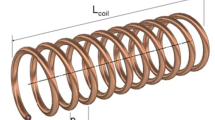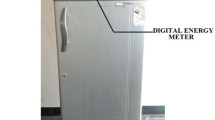Abstract
This paper presents an experimental investigation for the flow of liquefied petroleum gas (LPG) as a refrigerant inside an adiabatic helically coiled capillary tube in vapour compression refrigeration system. The effect of various geometric parameters and operating conditions like capillary tube inner diameter, length of capillary tube, coil diameter and different inlet subcoolings on the mass flow rate of LPG through the helical coiled capillary tube geometry has been investigated. It has been established that the coil diameter significantly influences the mass flow rate of LPG through the adiabatic helical capillary tube. It has been concluded that the effect of coiling of capillary tube reduces the mass flow rate by 5–12 % as compared to those of the straight capillary tube operating under similar conditions. The data obtained from the experiments are analyzed and a dimensionless correlation has been developed. The proposed correlation predicts that more than 90 % of experimental data which is in agreement with measured data in an error band of ±10 %.






Similar content being viewed by others
Abbreviations
- c p :
-
Specific heat at constant pressure (J kg−1 K−1)
- D :
-
Coil diameter of capillary tube (m)
- d :
-
Capillary tube inner diameter (m)
- L :
-
Capillary tube length (m)
- \( \dot{m} \) :
-
Mass flow rate (kg s−1)
- M :
-
Number of repeating variables
- N :
-
Total number of variables
- P :
-
Inlet pressure of capillary tube (Pa)
- ∆T sub :
-
Degree of subcooling (K)
- ρ :
-
Density (kg m−3)
- μ :
-
Coefficient of viscosity (kg m−1 s−1)
- f:
-
Liquid
References
Khan MK, Kumar R, Sahoo PK (2007) Flow characteristics of refrigerants flowing inside an adiabatic spiral capillary tube. HVAC&R Res. 13(5):731–748
Khan MK, Kumar R, Sahoo PK (2008) An experimental study of the flow of R-134a inside an adiabatic spirally coiled capillary tube. Int J Refrig 31:970–978
Kim SG, Ro ST, Kim MS (2002) Experimental investigation of the performance of R22, R407C and R410A in several capillary tubes for air-conditioners. Int J Refrig 25:521–531
Kuehl SJ, Goldschmidt VW (1990) Steady flows of R-22 through capillary tubes: test data. ASHRAE Trans 96(1):719–728
McLinden MO, Klien SA, Lemmon EW (2002) REFPROP-Version 7—thermodynamic and transport properties of refrigerants and refrigerant mixtures. NIST Standard Reference Database
Melo C, Ferreira RTS, Neto CB, Goncalves JM, Mezavila MM (1999) An experimental analysis of adiabatic capillary tube. Appl Therm Eng 19:669–684
Mittal MK, Kumar R, Gupta A (2009) Numerical analysis of adiabatic flow of refrigerant through a spiral capillary tube. Int J Thermal Sci 48(7):1348–1354
Park C, Lee S, Kang H, Kim Y (2007) Experimentation and modeling of refrigerant flow through coiled capillary tube. Int J Refrig 30:1168–1175
Valladares G (2007) Numerical simulation and experimental validation of coiled adiabatic capillary tubes. Appl Therm Eng 27:1062–1071
White FM (1994) Fluid mechanics, 3rd edn. McGraw-Hill, New York
Zhou G, Zhang Y (2006) Numerical and experimental investigations on the performance of coiled adiabatic capillary tube. Appl Therm Eng 26:1106–1114
Zhou G, Zhang Y (2006) Experimental investigation on hysteresis effect of refrigerant flowing through a coiled adiabatic capillary tube. Energy Conv Manag 47:3084–3093
Zhou G, Zhang Y (2012) Inlet pressure fluctuation characteristics of coiled adiabatic capillary tubes. Appl Therm Eng 33–34:183–189
Author information
Authors and Affiliations
Corresponding author
Rights and permissions
About this article
Cite this article
Punia, S.S., Singh, J. An experimental study of the flow of LPG as refrigerant inside an adiabatic helical coiled capillary tube in vapour compression refrigeration system. Heat Mass Transfer 51, 1571–1577 (2015). https://doi.org/10.1007/s00231-015-1523-5
Received:
Accepted:
Published:
Issue Date:
DOI: https://doi.org/10.1007/s00231-015-1523-5




